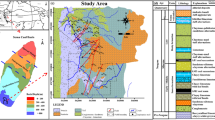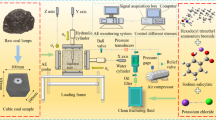Abstract
Coal mine methane (CMM) accumulation and permeability distribution characterization are the bases for a successful CMM drainage design. Before extending degassing activities, the prediction of the gas pressure and permeability distributions of the pre-drainage area is recommended. The effects of CMM geology on gas occurrence and coal permeability have drawn much attention and contributed to numerous research findings. However, the loco-regional distribution characteristics of the gas occurrence and coal permeability induced by landform characteristics have barely been investigated. This paper presents a quantitative case study on the non-uniform distributions of the gas pressure and coal permeability induced by the Loess Plateau geomorphology. Based on the collection and analysis of a large amount of data, the non-uniform distribution of the burial depth was first obtained. The relationship between the burial depth and gas pressure was analyzed by using the safety line method. A series of efforts were made to perform experimental tests for determining the competing influences of the effective stresses and sorption-induced strain on the coal permeability, and the relationship between the burial depth and coal permeability was analyzed by using the modified PM model. Finally, a quantitative evaluation of the non-uniform distributions of the gas pressure and coal permeability induced by the Loess Plateau geomorphology was achieved. The results showed that the statistical burial depth, gas pressure, and permeability of the No. 3 coal seam were irregular with large loco-regional changes, and the range of the burial depth was from 349 to 479 m. Further, the predicted pressure was from 0.81 to 1.66 MPa, and the predicted permeability was from 0.0155 to 0.01968 mD. When using both the gas pressure and coal permeability as the evaluation indices of the difficulty of gas drainage, the study area could be divided into six parts and classified into two groups. The division of a coal seam influenced by the Loess Plateau geomorphology will provide essential information formulation and economical plan to degas it.











Similar content being viewed by others
References
Brace, W., Walsh, J., & Frangos, W. (1968). Permeability of granite under high pressure. Journal of Geophysical Research,73(6), 2225–2236.
Brown, E., & Hoek, E. (1978). Trends in relationships between measured in situ stresses and depth. International Journal of Rock Mechanics and Mining Sciences & Geomechanics Abstracts,15(4), 211–215.
Chatterjee, R., Mukhopadhyay, M., & Paul, S. (2011). Overpressure zone under the Krishna–Godavari offshore basin: Geophysical implications for natural hazard in deeper-water drilling. Natural Hazards,57(1), 121–132.
Chatterjee, R., & Pal, P. K. (2010). Estimation of stress magnitude and physical properties for coal seam of Rangamati area, Raniganj coalfield, India. International Journal of Coal Geology,81(1), 25–36.
Chen, D., Pan, Z., Shi, J., Si, G., Ye, Z., & Zhang, J. (2016). A novel approach for modelling coal permeability during transition from elastic to post-failure state using a modified logistic growth function. International Journal of Coal Geology,163, 132–139.
Cheng, Y., Fu, J., & Yu, Q. (2009). Development of gas extraction technology in coal mines of China. Journal of Mining & Safety Engineering,26(2), 127–139.
Doyen, P. M. (1988). Permeability, conductivity, and pore geometry of sandstone. Journal of Geophysical Research: Solid Earth (1978–2012),93(B7), 7729–7740.
Gensterblum, Y., Merkel, A., Busch, A., Krooss, B. M., & Littke, R. (2014). Gas saturation and CO2 enhancement potential of coalbed methane reservoirs as a function of depth. Aapg Bulletin,98(2), 395–420.
Gilman, A., & Beckie, R. (2000). Flow of coal-bed methane to a gallery. Transport in Porous Media,41(1), 1–16.
Huang, B., Cheng, Q., & Chen, S. (2016). Phenomenon of methane driven caused by hydraulic fracturing in methane-bearing coal seams. International Journal of Mining Science and Technology,26(5), 919–927.
Huy, P. Q., Sasaki, K., Sugai, Y., & Ichikawa, S. (2010). Carbon dioxide gas permeability of coal core samples and estimation of fracture aperture width. International Journal of Coal Geology,83(1), 1–10.
Jin, K., Cheng, Y., Wang, L., Dong, J., Guo, P., An, F., et al. (2015). The effect of sedimentary redbeds on coalbed methane occurrence in the Xutuan and Zhaoji Coal Mines, Huaibei Coalfield, China. International Journal of Coal Geology,137, 111–123.
Kang, H., Zhang, X., Si, L., Wu, Y., & Gao, F. (2010). In-situ stress measurements and stress distribution characteristics in underground coal mines in China. Engineering Geology,116(3–4), 333–345.
Lamarre, R. A. (2003). Hydrodynamic and stratigraphic controls for a large coalbed methane accumulation in Ferron coals of east-central Utah. International Journal of Coal Geology,56(1), 97–110.
Li, J., Liu, D., Yao, Y., Cai, Y., & Chen, Y. (2013). Evaluation and modeling of gas permeability changes in anthracite coals. Fuel,111, 606–612.
Li, J., Lu, S., Cai, Y., Xue, H., & Cai, J. (2017). Impact of coal ranks on dynamic gas flow: An experimental investigation. Fuel,194, 17–26.
Li, Y., Shang, D., Hu, H., Meng, S., Liu, Y., Liu, Y., et al. (2014). Characteristic of in situ stress field in Liulin area, Ordos Basin and its control on coal fractures. Journal of China Coal Society,39(1), 164–168.
Lian, C., & Li, W. (2008). Exploration on the enhance of gas pressure prediction accuracies in coal seam. Journal of Henan Polytechnic University (Natural Science),27(2), 131–139.
Liu, J., Chen, Z., Elsworth, D., Qu, H., & Chen, D. (2011). Interactions of multiple processes during CBM extraction: A critical review. International Journal of Coal Geology,87(3), 175–189.
Liu, Q., Cheng, Y., Zhou, H., Guo, P., An, F., & Chen, H. (2015). A mathematical model of coupled gas flow and coal deformation with gas diffusion and Klinkenberg effects. Rock Mechanics and Rock Engineering,48(3), 1163–1180.
Liu, D., & Li, J. (2014). Main geological controls on distribution and occurrence and enrichment patterns of coalbed methane in China. Coal Science and Technology,42(6), 19–24.
Liu, Q., Zhang, K., Zhou, H., Cheng, Y., Zhang, H., & Wang, L. (2018). Experimental investigation into the damage-induced permeability and deformation relationship of tectonically deformed coal from Huainan coalfield, China. Journal of Natural Gas Science and Engineering,60, 202–213.
Mamunya, L. A. (1975). A problem of gas pressure prediction. Soviet Automatic Control,8(2), 62–65.
Meng, S., Lan, J., Liu, C., Ji, Y., Li, S., & Zhang, X. (2013). In-situ stress and coal reservoir pressure in Southeast margin of Ordos basin and their coupling relations. Journal of China Coal Society,38(1), 122–128.
Meng, Y., Tang, D., Xu, H., Li, C., Li, L., & Meng, S. (2014). Geological controls and coalbed methane production potential evaluation: A case study in Liulin area, eastern Ordos Basin, China. Journal of Natural Gas Science and Engineering,21, 95–111.
Mitra, A., Harpalani, S., & Liu, S. (2012). Laboratory measurement and modeling of coal permeability with continued methane production: Part 1—Laboratory results. Fuel,94, 110–116.
Pal, P. K., Paul, S., & Chatterjee, R. (2015). Estimation of in-situ stress and coal bed methane potential of coal seams from analysis of well logs, ground mapping and laboratory data in central part of Jharia Coalfield—An overview. In S. Mukherjee (Ed.), Petroleum geosciences: Indian contexts (pp. 143–173). Cham: Springer.
Palmer, I. (2009). Permeability changes in coal: Analytical modeling. International Journal of Coal Geology,77(1–2), 119–126.
Pan, Z., & Connell, L. D. (2007). A theoretical model for gas adsorption-induced coal swelling. International Journal of Coal Geology,69(4), 243–252.
Pan, Z., Connell, L. D., & Camilleri, M. (2010). Laboratory characterisation of coal reservoir permeability for primary and enhanced coalbed methane recovery. International Journal of Coal Geology,82(3–4), 252–261.
Paul, S., & Chatterjee, R. (2011). Determination of in situ stress direction from cleat orientation mapping for coal bed methane exploration in south-eastern part of Jharia coalfield. India. International Journal of Coal Geology,87(2), 87–96.
Robertson, E. P., & Christiansen, R. L. (2005). Modeling permeability in coal using sorption-induced strain data. In SPE annual technical conference and exhibition.
Shi, J., & Durucan, S. (2005). A model for changes in coalbed permeability during primary and enhanced methane recovery. SPE Reservoir Evaluation & Engineering,8(4), 291–299.
Shi, H., & Shao, M. (2000). Soil and water loss from the Loess Plateau in China. Journal of Arid Environments,45(1), 9–20.
Tang, X., Li, Z., Ripepi, N., Louk, A. K., Wang, Z., & Song, D. (2015). Temperature-dependent diffusion process of methane through dry crushed coal. Journal of Natural Gas Science & Engineering,22, 609–617.
Wang, L., Cheng, Y., Wang, L., Guo, P., & Li, W. (2012). Safety line method for the prediction of deep coal-seam gas pressure and its application in coal mines. Safety Science,50(3), 523–529.
Wu, Z., Jiang, S., Wang, K., Shao, H., Zhou, S., He, X., et al. (2016). Experimental study on f-ω regulation model under abnormal methane emission. International Journal of Mining Science and Technology,26(6), 1153–1159.
Yao, Y., Liu, D., & Yan, T. (2014). Geological and hydrogeological controls on the accumulation of coalbed methane in the Weibei field, southeastern Ordos Basin. International Journal of Coal Geology,121, 148–159.
Zhang, H., Liu, J., & Elsworth, D. (2008). How sorption-induced matrix deformation affects gas flow in coal seams: A new FE model. International Journal of Rock Mechanics and Mining Sciences,45(8), 1226–1236.
Zhao, G., Mu, X., Wen, Z., Wang, F., & Gao, P. (2013). Soil erosion, conservation, and eco-environment changes in the loess plateau of China. Land Degradation and Development,24(5), 499–510.
Zhou, F., Sun, Y., Li, H., & Yu, G. (2016). Research on the theoretical model and engineering technology of the coal seam gas drainage hole sealing. Journal of China University of Mining & Technology,45(3), 433–439.
Acknowledgments
The authors are grateful to the financial support from the National Natural Science Foundation of China (No. 51704286) and a project funded by the Fundamental Research Funds for the Central Universities (No. 2017XKQY027), and a project funded by the Priority Academic Program Development of Jiangsu Higher Education Institutions.
Author information
Authors and Affiliations
Corresponding authors
Appendix
Appendix
The SI unit of permeability is m2; however, the field unit (mD) is much more widely used, and the gas permeability coefficient can be easily obtained by the field permeability test. The conversion relation between m2, mD, and m2/(MPa2 d) is listed in Table 5. From the table, it can be found using the field unit (mD) will make our writing more concise.
Rights and permissions
About this article
Cite this article
Liu, Q., Chu, P., Hao, C. et al. Non-uniform Distributions of Gas Pressure and Coal Permeability in Coalbed Methane Reservoirs Induced by the Loess Plateau Geomorphology: A Case Study in Ordos Basin, China. Nat Resour Res 29, 1639–1655 (2020). https://doi.org/10.1007/s11053-019-09566-6
Received:
Accepted:
Published:
Issue Date:
DOI: https://doi.org/10.1007/s11053-019-09566-6




